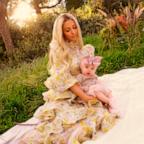'The Banana-Leaf Ball' aims to teach children through play
Katie Smith Milway used her travels to refugee camps in Africa to write book.
— -- When children's book author Katie Smith Milway was looking for inspiration for her next project, she found a life lesson worth sharing in the form of a banana-leaf ball.
Made from twine and banana tree leaves, a banana-leaf ball can be as small as a softball or as large as a soccer ball, and is used as a homemade replacement for manufactured sports balls among East African boys and girls.
Through her professional network, Milway got in touch with Johann Koss of the Right to Play program, whose volunteers coach sports for children in need worldwide.
Turning virtual lessons into life loans
Through Right to Play, she forged a long-distance connection with former refugee Benjamin Nzobonankira from Burundi. She adapted Nzobonankira's story of play with a banana-leaf ball for her latest children's book "The Banana-Leaf Ball: How Play Can Change the World" (illustrated by Shane W. Evans).
Her own travels to refugee camps in Africa also helped her craft the book’s narrative and illustrative direction.
“You walk into a refugee camp and you find people with all kinds of skills,” Milway told ABC News. “They've come from whatever their walk of life was. … You see people coming together and bringing their skills to a pretty, you know, a disadvantaged situation.”
“The Banana-Leaf Ball” follows the story of a young refugee named Deo, inspired by Nzobonankira, whose family fled Burundi during civil unrest in the 1990s. In the book, Deo overcomes the hardships of refugee life and bullying in the camp by making banana-leaf balls to share and play soccer with the other children who lived nearby.
“My quest really is to introduce kids to world issues they can do something about,” Milway said.
In a recent visit to P.S. 161 Pedro Albizu Campos School in New York City’s Harlem neighborhood, Milway shared the book with a group of children through a partnership with America Scores, a nonprofit that provides after-school programming to 10,000 urban youth in public and charter schools in 13 major cities across the United States and Canada.
“The central message of ‘The Banana-Leaf Ball’ is not just for refugee camps,” she said. “Honestly it's just as relevant to a playground here in Harlem where there are kids that don't trust each other and are not always nice to each other.”
Her focus throughout the book is the power of learning through play, she says, important for social and emotional development to succeed in both school and life.
“[‘The Banana-Leaf Ball’] story directly relates to what we do every day in our program,” Shannon Schneeman, the executive director of America Scores in New York, said. “We emphasize students learning through play, learning teamwork through play, making friends through play and learning some harder lessons as well: conflict resolution, how to become a true leader on their team and in their school and in their greater community.”
During Milway’s visits to America Scores programs, she often connects the students she is presenting to with Nzobonankira via Skype from his home country of Burundi, where he returned to after living in a Tanzania refugee camp for 15 years. He has since become a coach for Right to Play himself.
“We've been able to use Skype for him to actually come into the classroom and interact with kids and bring kids from Burundi in contact with kids from North America,” Milway said. “You really see the power of play crossing an ocean. And they will do the same kind of trust-building games that we profile in the book.”
And Schneeman says America Scores’ emphasis on learning through play has been working. Through data analysis, Schneeman says the New York schools America Scores works with have seen improvements in attendance, and English and Language Arts test scores.
“I realized what [America Scores] did was exactly what I had written about,” Milway said. “So it's really amazing to me to just see the incredible synergies there.”
Through the book and her presentations, Milway says she hopes the children she reaches learn something helpful for their own growth and personal achievement, to live more successful lives.
“I hope that it helps them,” she said. “I hope it’s fun for them."




